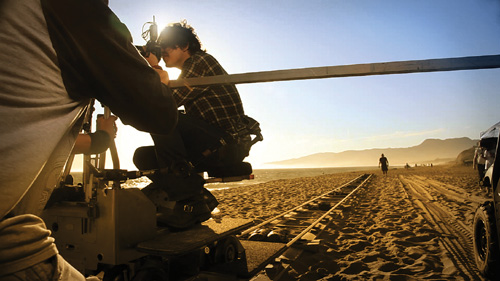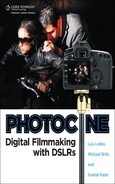
Think about the last time you were out to dinner with your friends. What did you talk about? Odds are that you bandied about stories. Stories about your day, your ride to the dinner, or a story from your past that illustrates your credibility on a subject that has come up from someone else’s recounting of a story. As photographers, much of what we do is capture stories in a single frame. Whether the story is contrived or actual, it is a unique skill to be able to present a narrative in a single still image. A skill that requires an inordinate amount of experience. A skill that is detrimental to telling a longer form narrative in motion.
The fundamental foundation that you need to embrace as you move into shooting narratives in motion is that of a three-act story. Billy Wilder once said, “In the first act of a story you put your character up in a tree, and the second act you set the tree on fire, and then in the third act you get him down.” In the most distilled, simplistic terms this quote is the essence of a good story. But where does this three-act structure come from and how do you learn it quickly so you can get your directing career off the couch and on to the screen? As it turns out, you already know it, you just don’t know that you know it.
The next time you are out at a social gathering and you start to recount a story of your own, think about how you’re telling the plot. It starts with a time period and the introduction of a location and the characters. “About ten years ago my girlfriend at the time and I were at a wedding in Jamaica. We were staying at the Rockhouse Hotel in Negril, which is right on these cliffs overlooking the Caribbean ocean.”
And then you go into the set up. “We were talking with another couple attending the wedding, who said they had just been to Cuba. The stories were fantastic about the old cars and the food and the architecture.”
And then you explain the catalyst. “The other couple told us it was easy to get to Cuba from Montego Bay, Jamaica. They used a service that specializes in getting Americans passage to Fidel Castro’s island.”
And then you talk about your trepidation or the debate. “My girlfriend and I looked at each other and thought about whether we would get in trouble with the U.S. government. Also keep in mind that you can’t use American credit cards in Cuba, so we had to get a lot of cash.” And then you talk about getting on the plane, seeing Cuba through the window, and then finally landing. If your friends encourage you for more details about your time in Cuba, you will subconsciously pick an event that stands out in your mind and then start the process with the set up, the debate, the adventure, and finally the conclusion.
Storytelling is a part of our DNA. Families have family stories and nations have national stories. We are the only creature on the planet that tells stories. It is how we narrate our existence and come to understand our place in the world, and it’s been with us a very long time.
In his book The Hero with a Thousand Faces, Joseph Campbell identified a fundamental story structure throughout the history of myths. Campbell noticed that all myths start with a call to adventure. If you consider my pedestrian example of getting to Cuba, it too starts with a call to adventure, an opportunity to go to a country where Americans aren’t allowed.
Now think about the stories that you convey about your day-to-day life. I’m not talking about the stream of complaints that you vomit on to your significant other or best friend because they happen to be within earshot of your voice. I’m talking about a narrative that your brain has deemed interesting enough to present to a group of people. An audience. If you look closely enough, you’ll see the call to adventure in all of them.
My cat starting foaming at the mouth, so I had to race to the vet.
I heard a bump in the night, so I got a flashlight and a baseball bat and starting looking around the house.
The traffic was dead stopped, so I started driving in the emergency lane.
In all these trivial examples, there is a call to action. And that, my friends, is how you get people’s attention. It is when your ordinary, day-to-day life is suddenly made extraordinary by an event or action.
The second part of the structure that Campbell identified is the hero’s path of trials. Think about how you structure the stories that you tell to your friends after you grab their attention. You talk about the events that occurred as the story unfolds. This is the point at which we’re apt to employ the most exaggeration. You’ll tell of the doubts that you had about going on the adventure, which is otherwise known as an internal debate. Then there are the physical obstacles. Cars don’t start, light switches don’t work—small enhancements to the actual details that give your story the pepper to keep your audience engaged.
If you’re inclined toward sports analogies, think about your favorite game of your favorite sport. Was it a close game? Was your favorite team in danger of losing the game a few times? Did you see your team rally with sheer determination? That, even though it’s on a field or the court, is an archetypical story. Overcoming obstacles to reach a goal.
Campbell identifies achieving the goal as the moment when the hero overcomes the obstacles that were thrown in front of him and reaches a level of self-awareness. The path to the goal has resulted in a more enlightened, more knowledgeable hero. It is the reward of experience that is bestowed upon the adventurer.
If you think about the most poignant stories from your own life, you’ll see a pattern of maturation that has resulted from all of them. For example, the college student who pursues the adventure of a semester abroad comes back more sophisticated and confident. We all have moments in our lives that have a profound effect on who we are and how we move forward with the rest of our lives. It is this feeling of returning to our lives, like a student who comes back to college after their semester in a foreign land, that Campbell tells us is a return to an ordinary world.
With the lessons of experience now a part of our personal history, it is up to us to apply them to our day-to-day existence. Having successfully completed our adventure, we can now use the lessons learned through the experience of the journey to change the world around us.
In the example of the student who goes abroad, he is endowed with experiences that could never be found in America. A different way of life, a different culture. All these will have a bearing on anything he does in the future. And his stories will be a contribution to the lives of his friends to whom he recounts his experiences. They may find their own call to adventure from such stories, thus continuing the cycle of expansion.
As you can see in these cliché examples overlaid on the patterns found in the long history of myths, stories are one of the most powerful facets of human existence. So the next time you watch a movie, you’ll know that it is basically a high-budget version of a human tradition.

Even if you’ve decided that writing and directing aren’t your thing and you just want to shoot, you still have a responsibility to the narrative. Cinematography takes the story written on the pages of a screenplay combined with the direction of the director and breathes visual life into it. Good cinematographers will create a visual story arc using lighting and angles.
The first mainstream television show to embrace DSLR filmmaking is the hit show House M.D. I sat down with Gale Tattersall, the cinematographer for House M.D. and asked him about the cinematography arc.
Some will think that my story-centric mantra does not consider artistic cinematic endeavors. I would argue that behind every piece of art is a story. Classical paintings depict religious parables, and events of the day that they were painted. If you were to counter that abstract art is devoid of a story, I would argue that it depicts the story that the artist sees in her head or the story she felt in her bones when she painted the piece. Just because the story on the canvas isn’t easily recognized as a typical story, doesn’t mean that it’s not.
So how do we distinguish what is good story telling and what is not, considering the vast interpretations that one can drawn from anything visual? My friends, you will know. If you string together a few scenes in a vignette and then look for a defensible meaning to what you’ve done, you’ve not done your job. If you do something highly abstract because you were driven to shoot with passion and instinct, you’ve told a story, no matter how obscure it may seem to viewers.
In the end, you must ask yourself this one simple question—does the story you are shooting have a beginning, a middle, and an end? If it doesn’t, it’s not a story.
